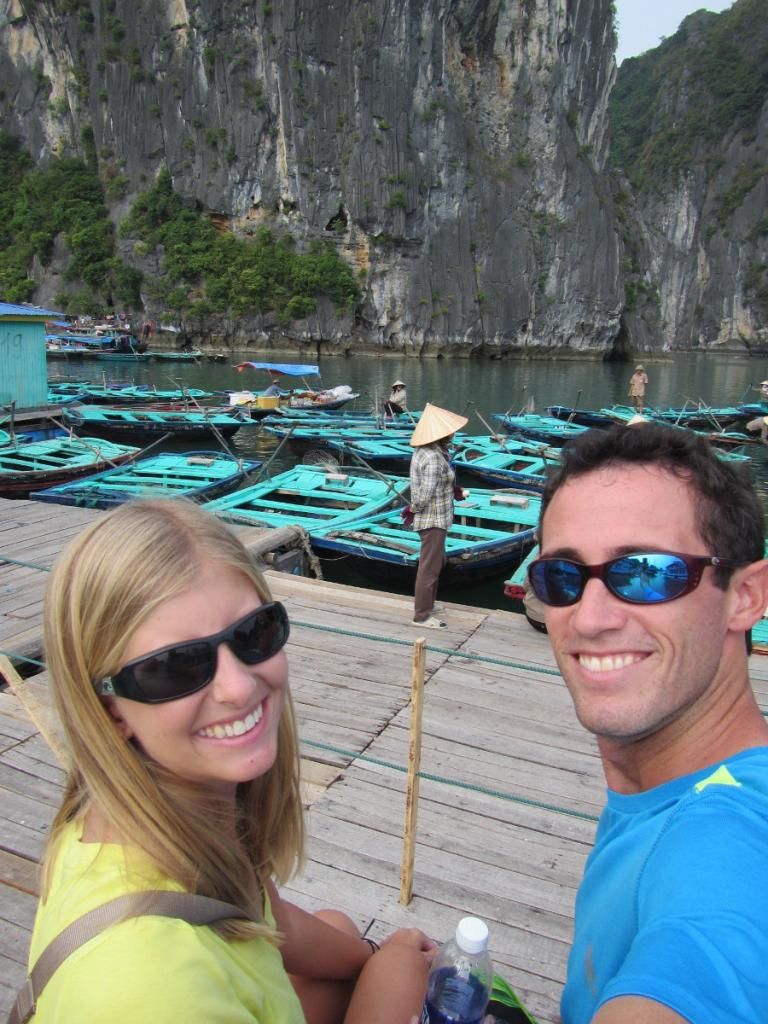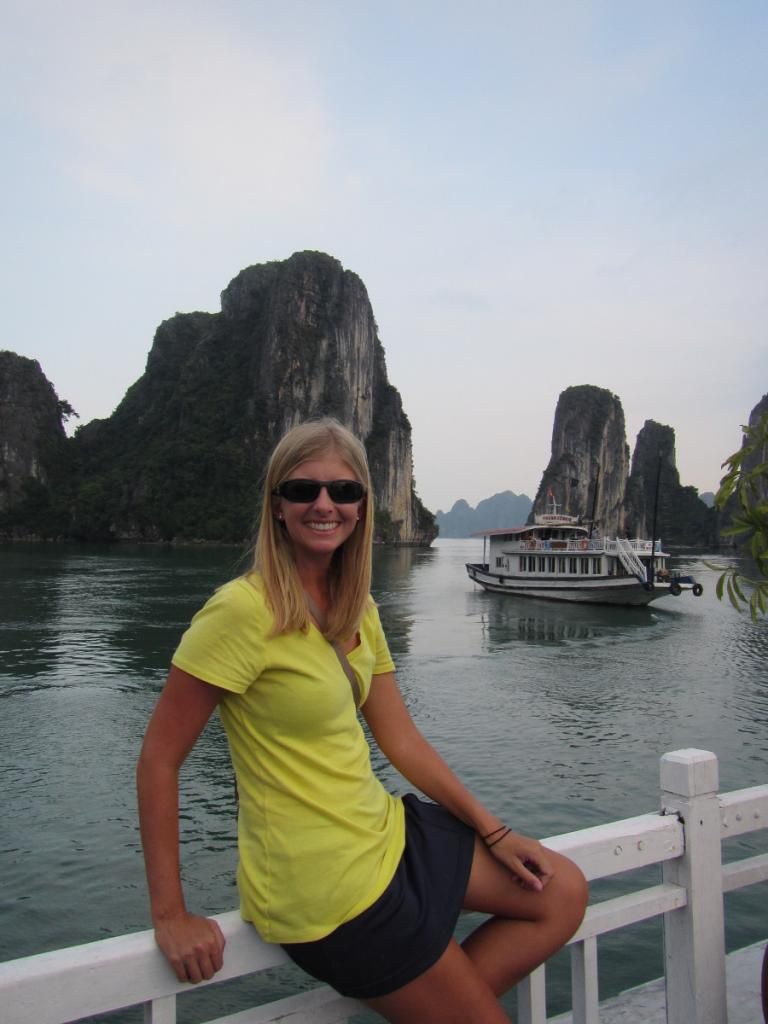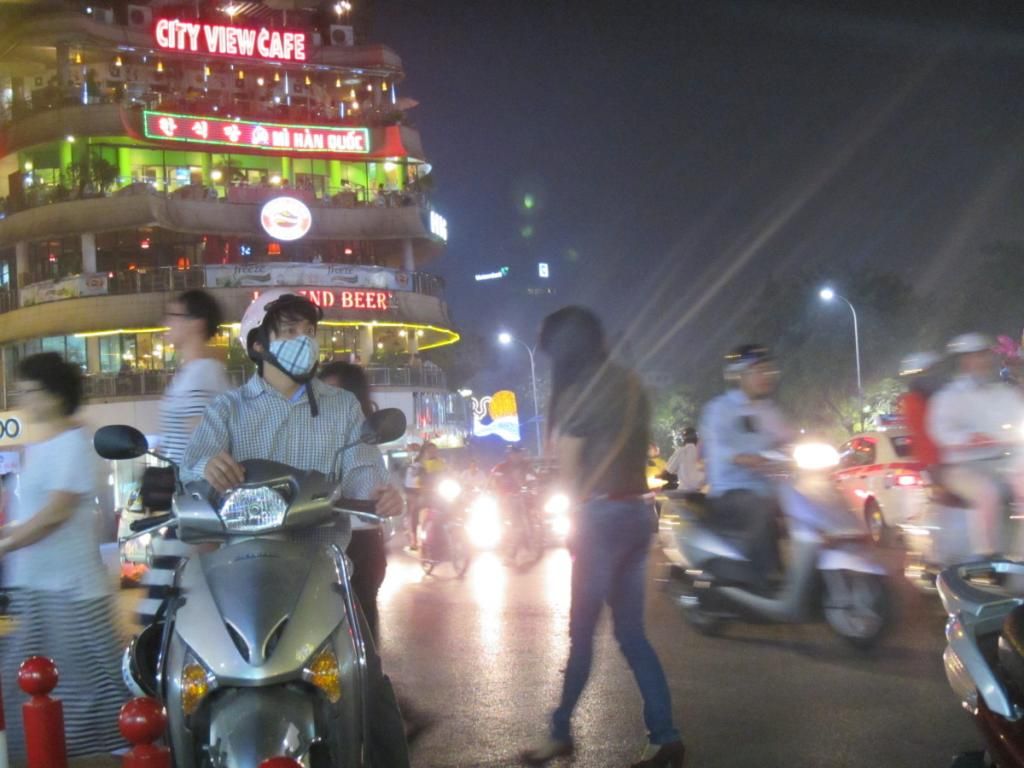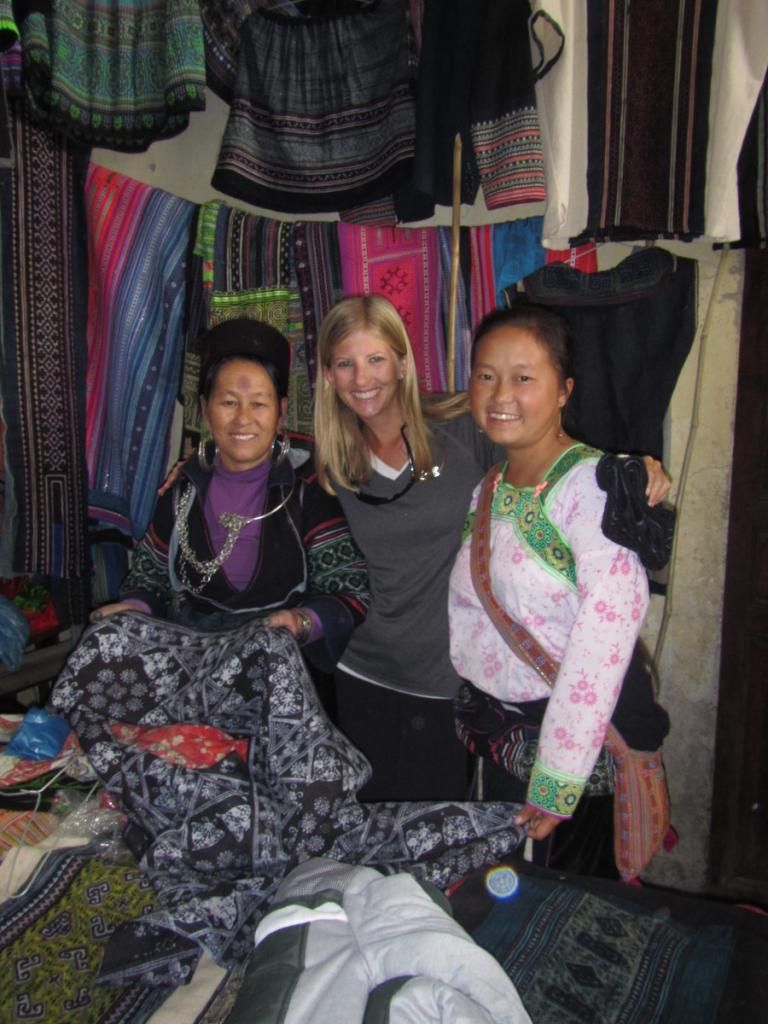We flew from Hoi An to Hanoi ($36) and
transferred via city bus to big bus station for Halong Bay. Next time
we will take a cab rather than a city bus, which was totally packed.
The driver even charged us extra for our bag. Luckily we had the help
of a student who personally walked us to the correct bus and got us
pointed in the right direction. Halong Bay is located on Vietnam's
coast, about 5 hours east of Hanoi. Halong Bay has just short of
2,000 natural limestone karsts that rise high and vertical above the
bay. These karsts are scattered with caves, beaches, and lakes. The
rock formations reminded us of the Lao Islands in Fiji. It took us a
morning to filter through the scams and find a boat that would take
us out on the water. The rickety old wooden “junk” boats in
Halong Bay depart with visitors on day and overnight cruises. The
captain of our junk boat casually sipped tea while we bopped around
the bay. Luckily we had good weather and we able to see the karsts in
the bay and enjoy a little sunshine.
Back in Hanoi, we caught up with our
family and made our long list of October 24th birthday calls to
Brian's dad, Lauren's dad, and Lauren's sister. Hanoi is super
smoggy, but the streets are filled with people going about their
daily lives wearing face masks. Obviously, the highlight of Hanoi was
the 25 cent beer. Every one sits along the street hanging out and
drinking cheap beer... so of course we had to partake. There are over
3.5 million motorbikes in Hanoi. Life is just so plain chaotic its
hard not to find it comical.
The highlight of our time in Vietnam
was definitely the time we spent in Sapa and the “Tonkinese Alps.”.
We heard great reviews from a friend about Sapa Sisters Trekking, a
company locally owned by local Hmong (pronounced Mong) women living
in the remote hill villages of Sapa. We stayed a night in a hotel in
the main town of Sapa, which also offered to store our larger bag
while we trekked in the countryside. Cho, our Sapa Sisters guide
works once or twice a week, depending on how many tourists are in
town and rotates with anywhere between 6-10 guides, all women.
Before leaving on the private trek, we
sat down with Cho to go over our options. There are many small
villages in the hills of Sapa and the trek routes have varying
difficulties. With a little hesitation, we chose the most challenging
route that led us up and down steep (and slippery!) sides of
mountains. Navigating us up, down, and around the slopes, Cho
scampered like a mountain goat. We managed to keep up with her and
Lauren came very close to taking a tumble in a massive pile of
buffalo poo. She slid about 5 feet and managed to stop still
standing. Everyone got their laughs. See the picture to get yours...
The views of mountains and rice terraces on our trek was
breathtaking. Because of the altitude, the air was cool and the
perfect temperature for days of walking.
Cho, taught us about plants growing
along the paths that are essential for medicine, food, and clothing
in the Hmong Villages. She showed us which plants were poison and
told us that it is common for women to eat poisonous leaves when they
are not happy with their husbands. We had already noticed that the
local women in the markets had blue hands and Cho showed that
crushing the leaves of the indigo plants in our hands would leave a
blue stain. Hmong clothing is made by twisting strands of hemp to
create a thread and using a loom to weave. Marijuana plants are
plentifully grown around the villages and are the primary material
used for hemp textiles. The indigo leaves are crushed with water and
used to create a navy blue dye. Traditional Hmong clothes have neon
embroidery on the navy blue material. Patterns and designs are made
on the fabric using beeswax before the dying process. After the cloth
is dyed, it is put into boiling water and the wax is removed, leaving
a white pattern on the indigo.
Like most Hmong, Cho spoke almost
perfect English, but was unable to read or write. In the villages
people speak Hmong, but also English and a little Vietnamese. Cho was
21 years old and already was married with a 2 year old girl and an 8
month old boy. It's not uncommon for people to marry young and have
children. Responsibility to the family is a strong sentiment. When
girls are married they move to the husband's family. The family is
the center of life in Sapa's Hmong villages and many generations
inhabit the same home. Cho told us how important it is to have sons
because they marry and care for the elders of the family, while girls
will eventually marry and leave the family. Husbands are very
involved in cooking and cleaning and most of the women are the ones
that have jobs outside the home. Men are greatly involved in
supporting the women and raising children. All families grow rice at
a minimum.
We were very lucky to have perfect
weather for our days in the Hmong villages. Rain frequents the
mountains this time of year and the steep slopes can be very
slippery. During our trek, we stayed at a homestay in the hills that
provided a bed, bathroom, shower, food, “happy water” and a
valuable cultural experience. Our room in the homestay was a bed in a
simple framed pen with a mosquito net. We befriended a group of
American flight attendants who were also staying in the village
between trekking. They had picked up a few souvenirs in the marajuana
fields. In the evening we joined them at the little beer shop up and
road. The non-existant menu was sparse, but included opium. We stuck
to local beer.
While the flight attendants had their
fun, we sat around drinking happy water and asked them about some of
the weirdest thing they have seen on planes. We are recently coming
off three straight plane rides in close proximity to crying babies.
One of the girls told us a story about a man who had no arms and was
flying in company of a service monkey. When it came time to eat the
monkey started feeding the guy, as usual. But there was something
wrong with the monkey and he was stuffing food into the guy's mouth
faster than he could chew and scratching the man's face in the
process. When the guy began choking, the flight attendants noticed
the monkeys strange behavior, still stuffing food into the guy's
mouth and clawing his face. One of the flight attendants grabbed the
monkey by the neck and threw him into the restroom and locked the
door. The monkey trashed around the first class restroom in panic.
The pilots even hear the scuffle since the restroom shared a wall
with the cockpit. Luckily a veterinarian that was on the plane
suggested that the monkey was suffering from the pressure in the
plane and needed oxygen. They got the monkey out of the restroom and
gave him back to his owner with an oxygen mask and he acted normal
the rest of the flight (as normal as service monkeys on a plane could
act). It may have been the “happy water” but everyone got a huge
kick out of the story, including the Hmong women. We just had to
include it in the email since this is the most absurd story we have
heard in almost a year of traveling.
Returning to the main town of Sapa, was
fun as we fast tracked through the hills on motorbikes with Cho, her
husband, and their little baby boy. Cho took us to the market so we
could buy a meter or two of indigo hemp fabric dyed with beeswax. Her
mother owns a stand at the market, but was not there so we purchased
from her neighbor.
Our adventure continues in Laos!
 |
 |
 |
 |
 |
 |
 |
 |


Hi. We are the TravelGorillas.com. We chanced upon your blog and enjoyed the read.
ReplyDeleteTravelGorillas.com links you directly to 30,000+ travel specialists worldwide who will compete to plan your trip, therefore giving you the best tours with the most competitive prices. So do share with us your next vacation plans and create your ideal trip.